Patient Positioning in Intensive Care: Minimizing Complications in ICU
VerifiedAdded on 2023/01/13
|10
|4111
|26
Report
AI Summary
This report delves into the critical role of patient body positioning as a fundamental nursing intervention within the intensive care unit (ICU). It emphasizes the strategic alignment of patients to optimize organ function and enhance nursing care, leveraging the effects of gravity to prevent complications. The report explores various positions, including supine, prone, lateral, Sims, Fowler's, semi-Fowler's, tripod, and Trendelenburg, and their impact on preventing conditions like increased intracranial pressure (ICP), ventilator-associated pneumonia (VAP), and acute respiratory distress syndrome (ARDS). The report examines how specific positions affect cerebral perfusion, oxygenation levels, and the risk of aspiration and reflux, highlighting the importance of head elevation and neck alignment. It also discusses the significance of repositioning protocols, hygiene care considerations, and the potential risks associated with mechanical ventilation. Current research suggests that the prone position increases oxygenation, and the report weighs the pros and cons of each approach, emphasizing the need for tailored positioning strategies to improve patient outcomes.
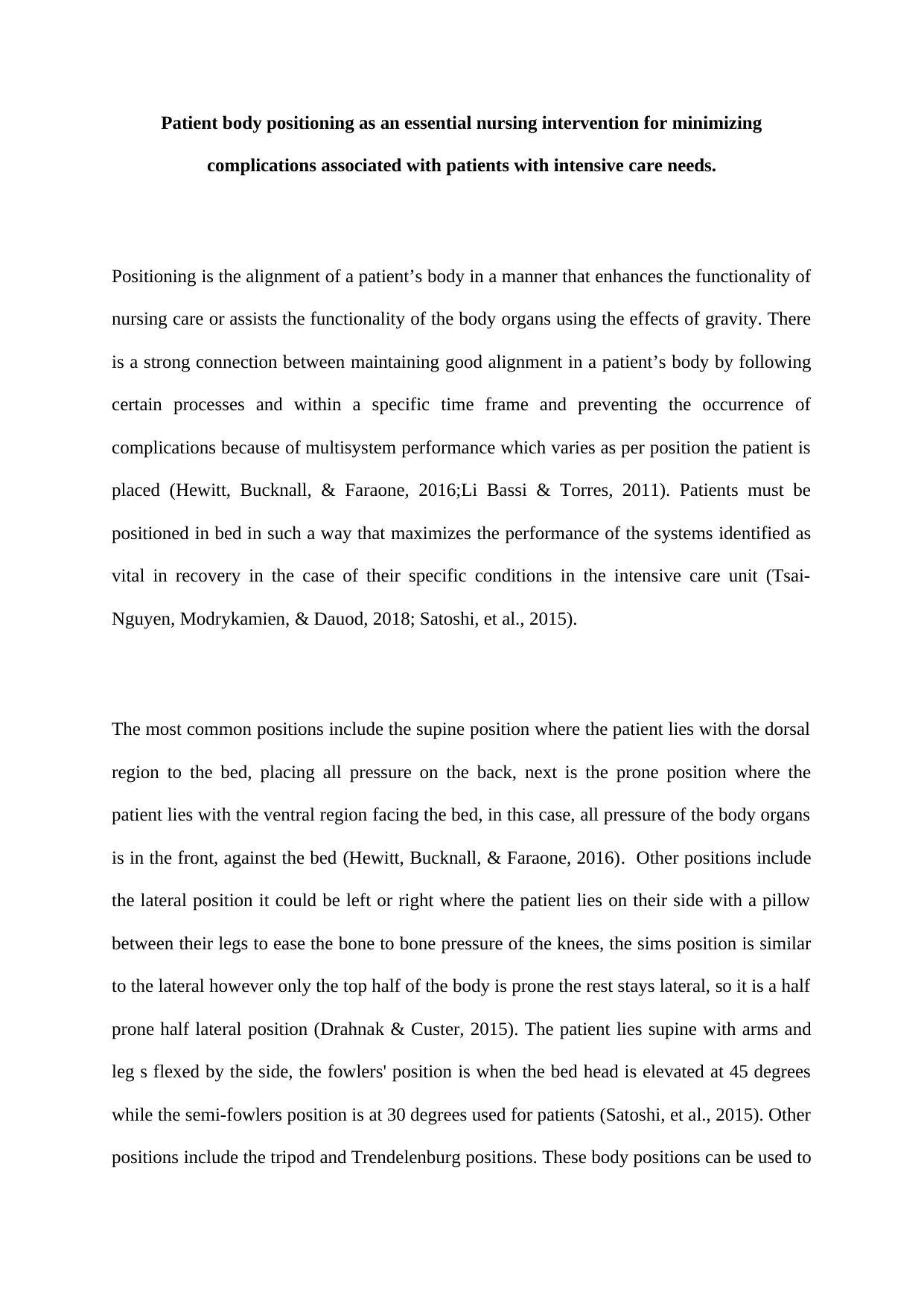
Patient body positioning as an essential nursing intervention for minimizing
complications associated with patients with intensive care needs.
Positioning is the alignment of a patient’s body in a manner that enhances the functionality of
nursing care or assists the functionality of the body organs using the effects of gravity. There
is a strong connection between maintaining good alignment in a patient’s body by following
certain processes and within a specific time frame and preventing the occurrence of
complications because of multisystem performance which varies as per position the patient is
placed (Hewitt, Bucknall, & Faraone, 2016;Li Bassi & Torres, 2011). Patients must be
positioned in bed in such a way that maximizes the performance of the systems identified as
vital in recovery in the case of their specific conditions in the intensive care unit (Tsai-
Nguyen, Modrykamien, & Dauod, 2018; Satoshi, et al., 2015).
The most common positions include the supine position where the patient lies with the dorsal
region to the bed, placing all pressure on the back, next is the prone position where the
patient lies with the ventral region facing the bed, in this case, all pressure of the body organs
is in the front, against the bed (Hewitt, Bucknall, & Faraone, 2016). Other positions include
the lateral position it could be left or right where the patient lies on their side with a pillow
between their legs to ease the bone to bone pressure of the knees, the sims position is similar
to the lateral however only the top half of the body is prone the rest stays lateral, so it is a half
prone half lateral position (Drahnak & Custer, 2015). The patient lies supine with arms and
leg s flexed by the side, the fowlers' position is when the bed head is elevated at 45 degrees
while the semi-fowlers position is at 30 degrees used for patients (Satoshi, et al., 2015). Other
positions include the tripod and Trendelenburg positions. These body positions can be used to
complications associated with patients with intensive care needs.
Positioning is the alignment of a patient’s body in a manner that enhances the functionality of
nursing care or assists the functionality of the body organs using the effects of gravity. There
is a strong connection between maintaining good alignment in a patient’s body by following
certain processes and within a specific time frame and preventing the occurrence of
complications because of multisystem performance which varies as per position the patient is
placed (Hewitt, Bucknall, & Faraone, 2016;Li Bassi & Torres, 2011). Patients must be
positioned in bed in such a way that maximizes the performance of the systems identified as
vital in recovery in the case of their specific conditions in the intensive care unit (Tsai-
Nguyen, Modrykamien, & Dauod, 2018; Satoshi, et al., 2015).
The most common positions include the supine position where the patient lies with the dorsal
region to the bed, placing all pressure on the back, next is the prone position where the
patient lies with the ventral region facing the bed, in this case, all pressure of the body organs
is in the front, against the bed (Hewitt, Bucknall, & Faraone, 2016). Other positions include
the lateral position it could be left or right where the patient lies on their side with a pillow
between their legs to ease the bone to bone pressure of the knees, the sims position is similar
to the lateral however only the top half of the body is prone the rest stays lateral, so it is a half
prone half lateral position (Drahnak & Custer, 2015). The patient lies supine with arms and
leg s flexed by the side, the fowlers' position is when the bed head is elevated at 45 degrees
while the semi-fowlers position is at 30 degrees used for patients (Satoshi, et al., 2015). Other
positions include the tripod and Trendelenburg positions. These body positions can be used to
Secure Best Marks with AI Grader
Need help grading? Try our AI Grader for instant feedback on your assignments.
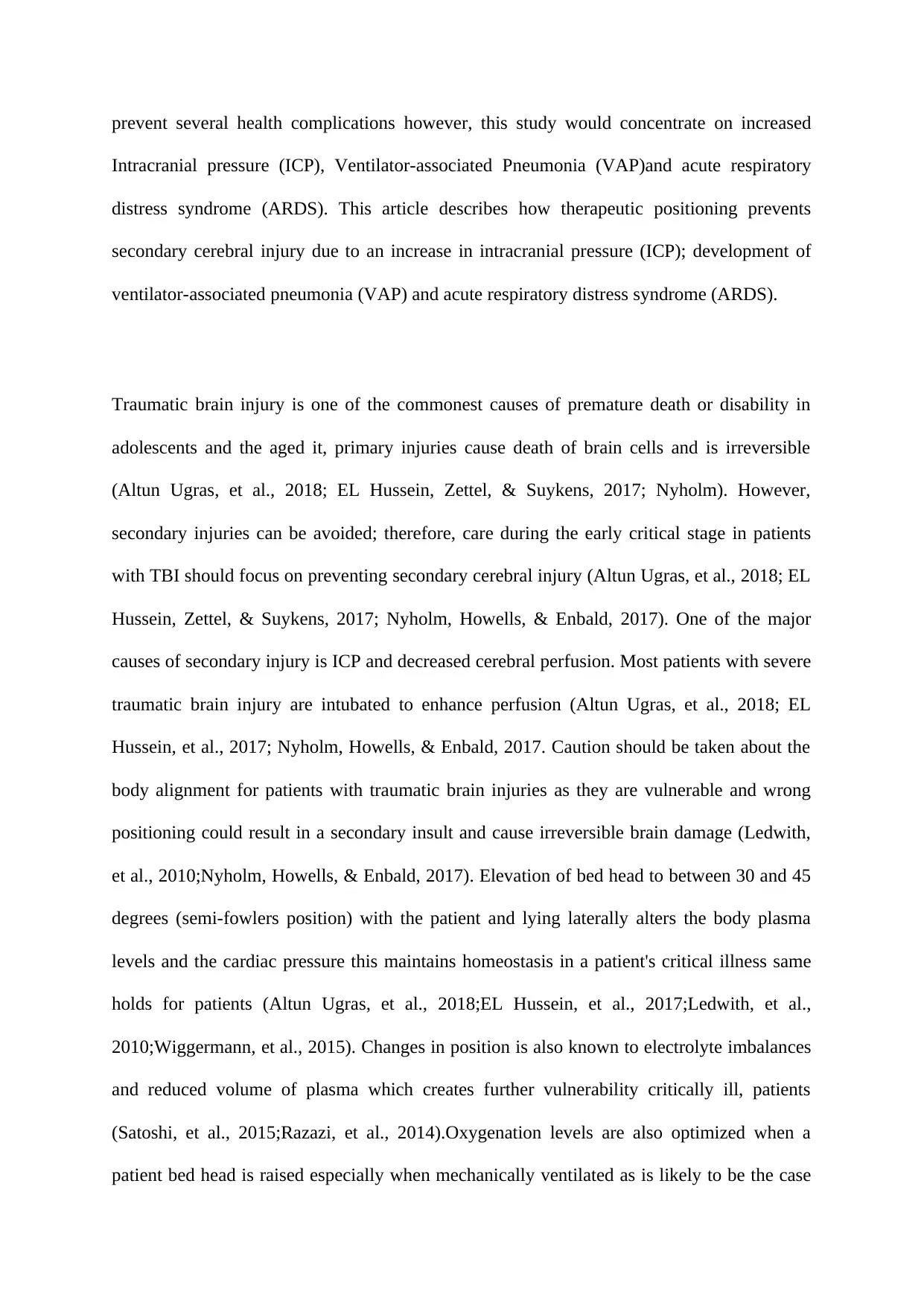
prevent several health complications however, this study would concentrate on increased
Intracranial pressure (ICP), Ventilator-associated Pneumonia (VAP)and acute respiratory
distress syndrome (ARDS). This article describes how therapeutic positioning prevents
secondary cerebral injury due to an increase in intracranial pressure (ICP); development of
ventilator-associated pneumonia (VAP) and acute respiratory distress syndrome (ARDS).
Traumatic brain injury is one of the commonest causes of premature death or disability in
adolescents and the aged it, primary injuries cause death of brain cells and is irreversible
(Altun Ugras, et al., 2018; EL Hussein, Zettel, & Suykens, 2017; Nyholm). However,
secondary injuries can be avoided; therefore, care during the early critical stage in patients
with TBI should focus on preventing secondary cerebral injury (Altun Ugras, et al., 2018; EL
Hussein, Zettel, & Suykens, 2017; Nyholm, Howells, & Enbald, 2017). One of the major
causes of secondary injury is ICP and decreased cerebral perfusion. Most patients with severe
traumatic brain injury are intubated to enhance perfusion (Altun Ugras, et al., 2018; EL
Hussein, et al., 2017; Nyholm, Howells, & Enbald, 2017. Caution should be taken about the
body alignment for patients with traumatic brain injuries as they are vulnerable and wrong
positioning could result in a secondary insult and cause irreversible brain damage (Ledwith,
et al., 2010;Nyholm, Howells, & Enbald, 2017). Elevation of bed head to between 30 and 45
degrees (semi-fowlers position) with the patient and lying laterally alters the body plasma
levels and the cardiac pressure this maintains homeostasis in a patient's critical illness same
holds for patients (Altun Ugras, et al., 2018;EL Hussein, et al., 2017;Ledwith, et al.,
2010;Wiggermann, et al., 2015). Changes in position is also known to electrolyte imbalances
and reduced volume of plasma which creates further vulnerability critically ill, patients
(Satoshi, et al., 2015;Razazi, et al., 2014).Oxygenation levels are also optimized when a
patient bed head is raised especially when mechanically ventilated as is likely to be the case
Intracranial pressure (ICP), Ventilator-associated Pneumonia (VAP)and acute respiratory
distress syndrome (ARDS). This article describes how therapeutic positioning prevents
secondary cerebral injury due to an increase in intracranial pressure (ICP); development of
ventilator-associated pneumonia (VAP) and acute respiratory distress syndrome (ARDS).
Traumatic brain injury is one of the commonest causes of premature death or disability in
adolescents and the aged it, primary injuries cause death of brain cells and is irreversible
(Altun Ugras, et al., 2018; EL Hussein, Zettel, & Suykens, 2017; Nyholm). However,
secondary injuries can be avoided; therefore, care during the early critical stage in patients
with TBI should focus on preventing secondary cerebral injury (Altun Ugras, et al., 2018; EL
Hussein, Zettel, & Suykens, 2017; Nyholm, Howells, & Enbald, 2017). One of the major
causes of secondary injury is ICP and decreased cerebral perfusion. Most patients with severe
traumatic brain injury are intubated to enhance perfusion (Altun Ugras, et al., 2018; EL
Hussein, et al., 2017; Nyholm, Howells, & Enbald, 2017. Caution should be taken about the
body alignment for patients with traumatic brain injuries as they are vulnerable and wrong
positioning could result in a secondary insult and cause irreversible brain damage (Ledwith,
et al., 2010;Nyholm, Howells, & Enbald, 2017). Elevation of bed head to between 30 and 45
degrees (semi-fowlers position) with the patient and lying laterally alters the body plasma
levels and the cardiac pressure this maintains homeostasis in a patient's critical illness same
holds for patients (Altun Ugras, et al., 2018;EL Hussein, et al., 2017;Ledwith, et al.,
2010;Wiggermann, et al., 2015). Changes in position is also known to electrolyte imbalances
and reduced volume of plasma which creates further vulnerability critically ill, patients
(Satoshi, et al., 2015;Razazi, et al., 2014).Oxygenation levels are also optimized when a
patient bed head is raised especially when mechanically ventilated as is likely to be the case
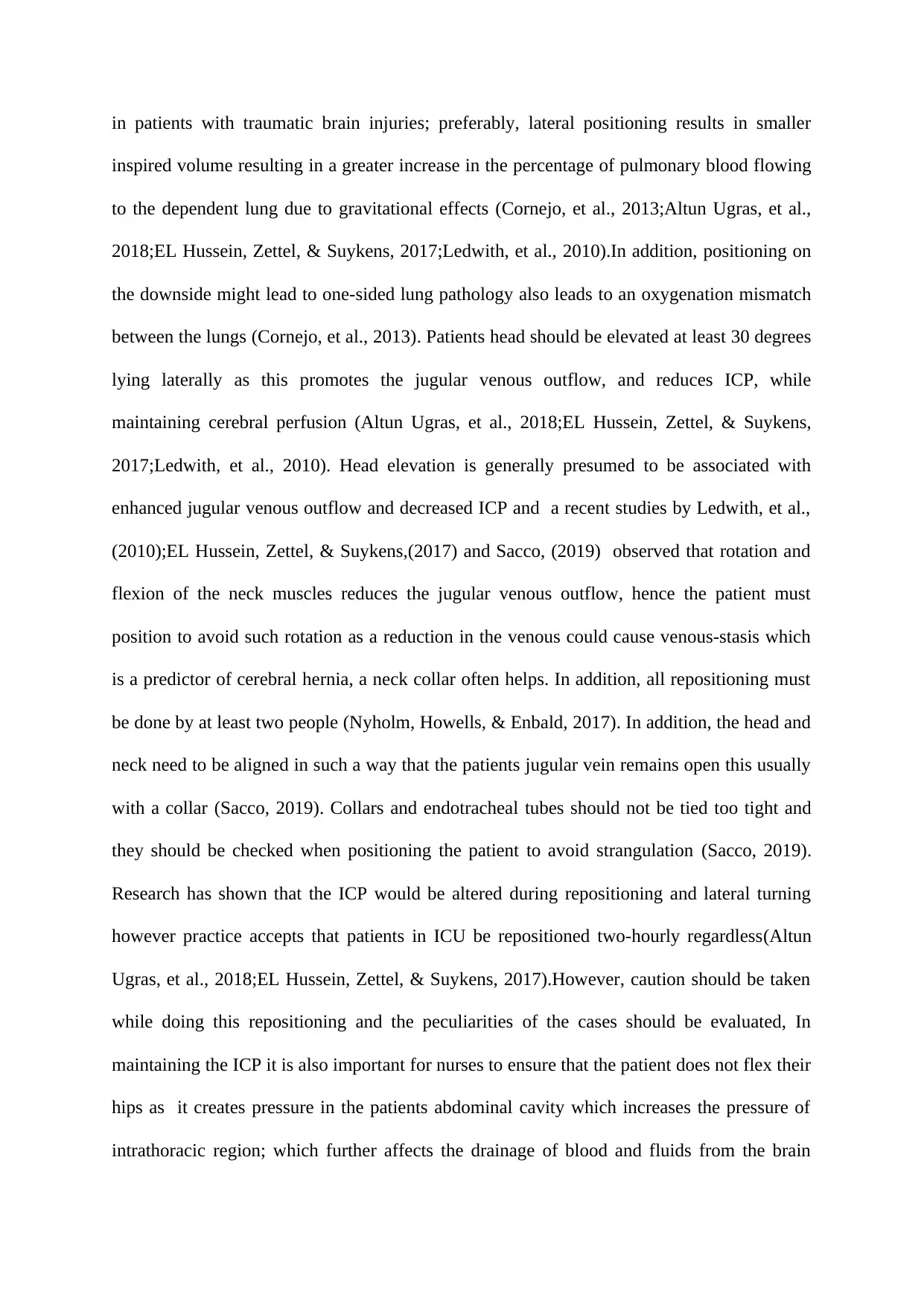
in patients with traumatic brain injuries; preferably, lateral positioning results in smaller
inspired volume resulting in a greater increase in the percentage of pulmonary blood flowing
to the dependent lung due to gravitational effects (Cornejo, et al., 2013;Altun Ugras, et al.,
2018;EL Hussein, Zettel, & Suykens, 2017;Ledwith, et al., 2010).In addition, positioning on
the downside might lead to one-sided lung pathology also leads to an oxygenation mismatch
between the lungs (Cornejo, et al., 2013). Patients head should be elevated at least 30 degrees
lying laterally as this promotes the jugular venous outflow, and reduces ICP, while
maintaining cerebral perfusion (Altun Ugras, et al., 2018;EL Hussein, Zettel, & Suykens,
2017;Ledwith, et al., 2010). Head elevation is generally presumed to be associated with
enhanced jugular venous outflow and decreased ICP and a recent studies by Ledwith, et al.,
(2010);EL Hussein, Zettel, & Suykens,(2017) and Sacco, (2019) observed that rotation and
flexion of the neck muscles reduces the jugular venous outflow, hence the patient must
position to avoid such rotation as a reduction in the venous could cause venous-stasis which
is a predictor of cerebral hernia, a neck collar often helps. In addition, all repositioning must
be done by at least two people (Nyholm, Howells, & Enbald, 2017). In addition, the head and
neck need to be aligned in such a way that the patients jugular vein remains open this usually
with a collar (Sacco, 2019). Collars and endotracheal tubes should not be tied too tight and
they should be checked when positioning the patient to avoid strangulation (Sacco, 2019).
Research has shown that the ICP would be altered during repositioning and lateral turning
however practice accepts that patients in ICU be repositioned two-hourly regardless(Altun
Ugras, et al., 2018;EL Hussein, Zettel, & Suykens, 2017).However, caution should be taken
while doing this repositioning and the peculiarities of the cases should be evaluated, In
maintaining the ICP it is also important for nurses to ensure that the patient does not flex their
hips as it creates pressure in the patients abdominal cavity which increases the pressure of
intrathoracic region; which further affects the drainage of blood and fluids from the brain
inspired volume resulting in a greater increase in the percentage of pulmonary blood flowing
to the dependent lung due to gravitational effects (Cornejo, et al., 2013;Altun Ugras, et al.,
2018;EL Hussein, Zettel, & Suykens, 2017;Ledwith, et al., 2010).In addition, positioning on
the downside might lead to one-sided lung pathology also leads to an oxygenation mismatch
between the lungs (Cornejo, et al., 2013). Patients head should be elevated at least 30 degrees
lying laterally as this promotes the jugular venous outflow, and reduces ICP, while
maintaining cerebral perfusion (Altun Ugras, et al., 2018;EL Hussein, Zettel, & Suykens,
2017;Ledwith, et al., 2010). Head elevation is generally presumed to be associated with
enhanced jugular venous outflow and decreased ICP and a recent studies by Ledwith, et al.,
(2010);EL Hussein, Zettel, & Suykens,(2017) and Sacco, (2019) observed that rotation and
flexion of the neck muscles reduces the jugular venous outflow, hence the patient must
position to avoid such rotation as a reduction in the venous could cause venous-stasis which
is a predictor of cerebral hernia, a neck collar often helps. In addition, all repositioning must
be done by at least two people (Nyholm, Howells, & Enbald, 2017). In addition, the head and
neck need to be aligned in such a way that the patients jugular vein remains open this usually
with a collar (Sacco, 2019). Collars and endotracheal tubes should not be tied too tight and
they should be checked when positioning the patient to avoid strangulation (Sacco, 2019).
Research has shown that the ICP would be altered during repositioning and lateral turning
however practice accepts that patients in ICU be repositioned two-hourly regardless(Altun
Ugras, et al., 2018;EL Hussein, Zettel, & Suykens, 2017).However, caution should be taken
while doing this repositioning and the peculiarities of the cases should be evaluated, In
maintaining the ICP it is also important for nurses to ensure that the patient does not flex their
hips as it creates pressure in the patients abdominal cavity which increases the pressure of
intrathoracic region; which further affects the drainage of blood and fluids from the brain
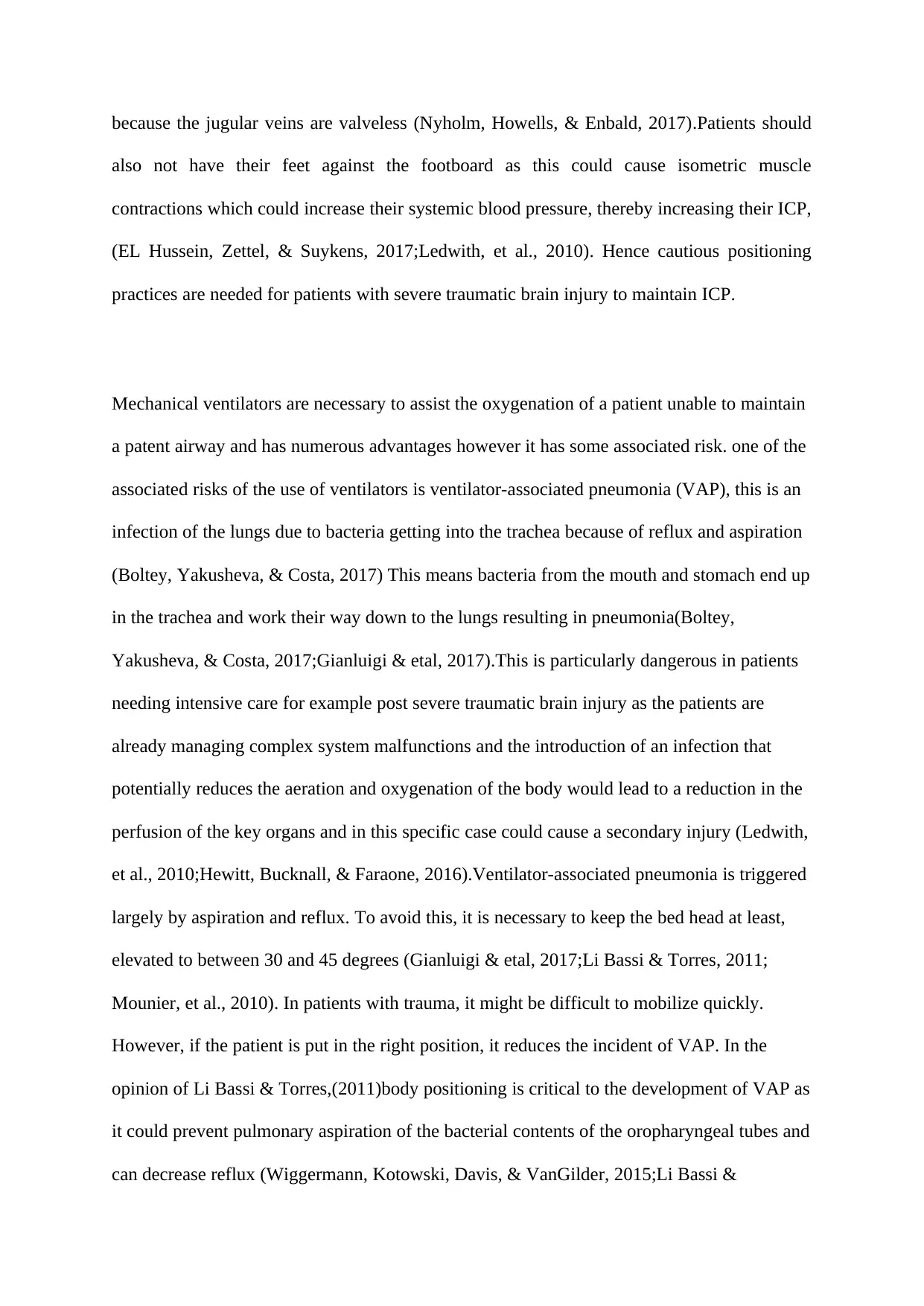
because the jugular veins are valveless (Nyholm, Howells, & Enbald, 2017).Patients should
also not have their feet against the footboard as this could cause isometric muscle
contractions which could increase their systemic blood pressure, thereby increasing their ICP,
(EL Hussein, Zettel, & Suykens, 2017;Ledwith, et al., 2010). Hence cautious positioning
practices are needed for patients with severe traumatic brain injury to maintain ICP.
Mechanical ventilators are necessary to assist the oxygenation of a patient unable to maintain
a patent airway and has numerous advantages however it has some associated risk. one of the
associated risks of the use of ventilators is ventilator-associated pneumonia (VAP), this is an
infection of the lungs due to bacteria getting into the trachea because of reflux and aspiration
(Boltey, Yakusheva, & Costa, 2017) This means bacteria from the mouth and stomach end up
in the trachea and work their way down to the lungs resulting in pneumonia(Boltey,
Yakusheva, & Costa, 2017;Gianluigi & etal, 2017).This is particularly dangerous in patients
needing intensive care for example post severe traumatic brain injury as the patients are
already managing complex system malfunctions and the introduction of an infection that
potentially reduces the aeration and oxygenation of the body would lead to a reduction in the
perfusion of the key organs and in this specific case could cause a secondary injury (Ledwith,
et al., 2010;Hewitt, Bucknall, & Faraone, 2016).Ventilator-associated pneumonia is triggered
largely by aspiration and reflux. To avoid this, it is necessary to keep the bed head at least,
elevated to between 30 and 45 degrees (Gianluigi & etal, 2017;Li Bassi & Torres, 2011;
Mounier, et al., 2010). In patients with trauma, it might be difficult to mobilize quickly.
However, if the patient is put in the right position, it reduces the incident of VAP. In the
opinion of Li Bassi & Torres,(2011)body positioning is critical to the development of VAP as
it could prevent pulmonary aspiration of the bacterial contents of the oropharyngeal tubes and
can decrease reflux (Wiggermann, Kotowski, Davis, & VanGilder, 2015;Li Bassi &
also not have their feet against the footboard as this could cause isometric muscle
contractions which could increase their systemic blood pressure, thereby increasing their ICP,
(EL Hussein, Zettel, & Suykens, 2017;Ledwith, et al., 2010). Hence cautious positioning
practices are needed for patients with severe traumatic brain injury to maintain ICP.
Mechanical ventilators are necessary to assist the oxygenation of a patient unable to maintain
a patent airway and has numerous advantages however it has some associated risk. one of the
associated risks of the use of ventilators is ventilator-associated pneumonia (VAP), this is an
infection of the lungs due to bacteria getting into the trachea because of reflux and aspiration
(Boltey, Yakusheva, & Costa, 2017) This means bacteria from the mouth and stomach end up
in the trachea and work their way down to the lungs resulting in pneumonia(Boltey,
Yakusheva, & Costa, 2017;Gianluigi & etal, 2017).This is particularly dangerous in patients
needing intensive care for example post severe traumatic brain injury as the patients are
already managing complex system malfunctions and the introduction of an infection that
potentially reduces the aeration and oxygenation of the body would lead to a reduction in the
perfusion of the key organs and in this specific case could cause a secondary injury (Ledwith,
et al., 2010;Hewitt, Bucknall, & Faraone, 2016).Ventilator-associated pneumonia is triggered
largely by aspiration and reflux. To avoid this, it is necessary to keep the bed head at least,
elevated to between 30 and 45 degrees (Gianluigi & etal, 2017;Li Bassi & Torres, 2011;
Mounier, et al., 2010). In patients with trauma, it might be difficult to mobilize quickly.
However, if the patient is put in the right position, it reduces the incident of VAP. In the
opinion of Li Bassi & Torres,(2011)body positioning is critical to the development of VAP as
it could prevent pulmonary aspiration of the bacterial contents of the oropharyngeal tubes and
can decrease reflux (Wiggermann, Kotowski, Davis, & VanGilder, 2015;Li Bassi &
Secure Best Marks with AI Grader
Need help grading? Try our AI Grader for instant feedback on your assignments.
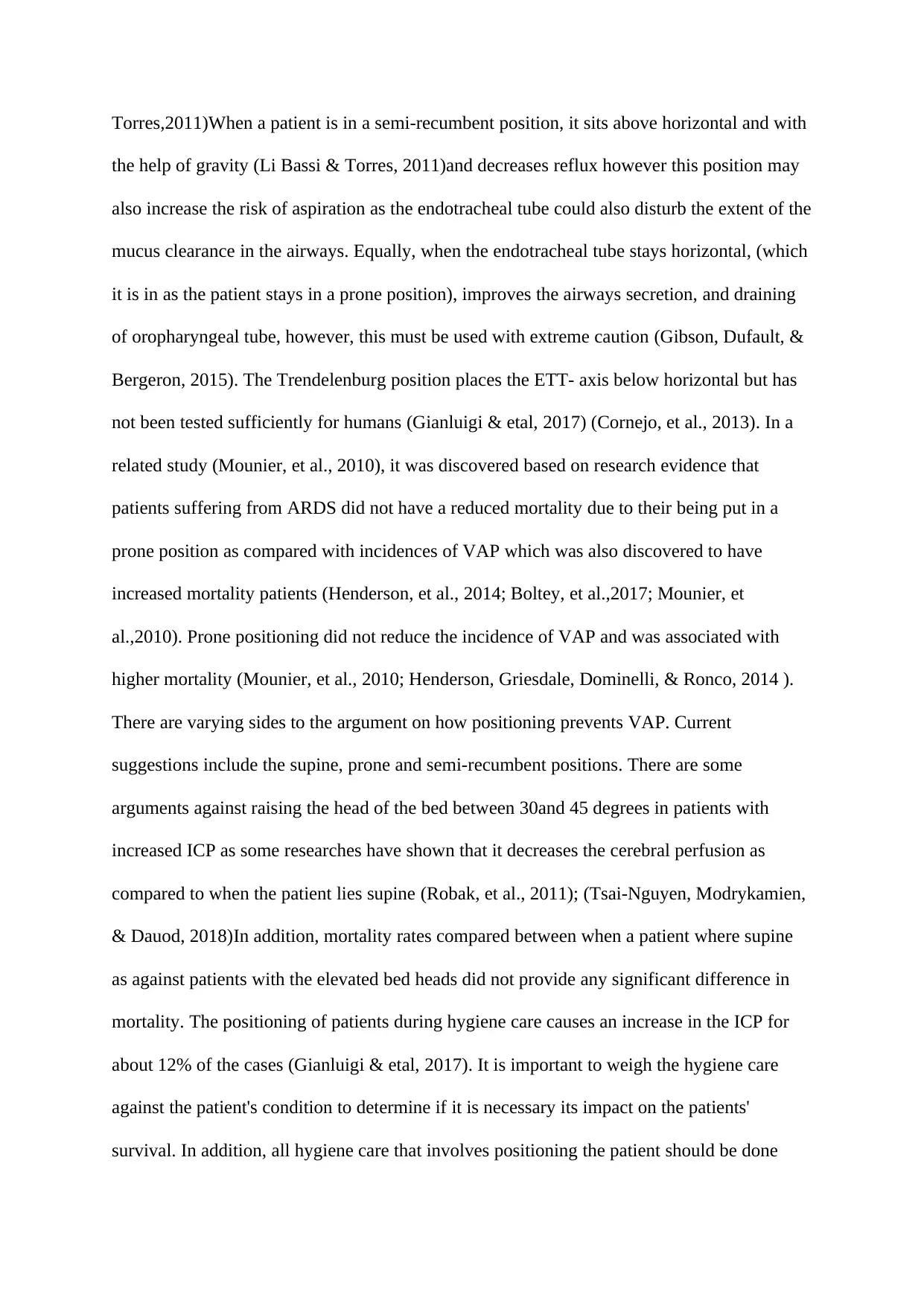
Torres,2011)When a patient is in a semi-recumbent position, it sits above horizontal and with
the help of gravity (Li Bassi & Torres, 2011)and decreases reflux however this position may
also increase the risk of aspiration as the endotracheal tube could also disturb the extent of the
mucus clearance in the airways. Equally, when the endotracheal tube stays horizontal, (which
it is in as the patient stays in a prone position), improves the airways secretion, and draining
of oropharyngeal tube, however, this must be used with extreme caution (Gibson, Dufault, &
Bergeron, 2015). The Trendelenburg position places the ETT- axis below horizontal but has
not been tested sufficiently for humans (Gianluigi & etal, 2017) (Cornejo, et al., 2013). In a
related study (Mounier, et al., 2010), it was discovered based on research evidence that
patients suffering from ARDS did not have a reduced mortality due to their being put in a
prone position as compared with incidences of VAP which was also discovered to have
increased mortality patients (Henderson, et al., 2014; Boltey, et al.,2017; Mounier, et
al.,2010). Prone positioning did not reduce the incidence of VAP and was associated with
higher mortality (Mounier, et al., 2010; Henderson, Griesdale, Dominelli, & Ronco, 2014 ).
There are varying sides to the argument on how positioning prevents VAP. Current
suggestions include the supine, prone and semi-recumbent positions. There are some
arguments against raising the head of the bed between 30and 45 degrees in patients with
increased ICP as some researches have shown that it decreases the cerebral perfusion as
compared to when the patient lies supine (Robak, et al., 2011); (Tsai-Nguyen, Modrykamien,
& Dauod, 2018)In addition, mortality rates compared between when a patient where supine
as against patients with the elevated bed heads did not provide any significant difference in
mortality. The positioning of patients during hygiene care causes an increase in the ICP for
about 12% of the cases (Gianluigi & etal, 2017). It is important to weigh the hygiene care
against the patient's condition to determine if it is necessary its impact on the patients'
survival. In addition, all hygiene care that involves positioning the patient should be done
the help of gravity (Li Bassi & Torres, 2011)and decreases reflux however this position may
also increase the risk of aspiration as the endotracheal tube could also disturb the extent of the
mucus clearance in the airways. Equally, when the endotracheal tube stays horizontal, (which
it is in as the patient stays in a prone position), improves the airways secretion, and draining
of oropharyngeal tube, however, this must be used with extreme caution (Gibson, Dufault, &
Bergeron, 2015). The Trendelenburg position places the ETT- axis below horizontal but has
not been tested sufficiently for humans (Gianluigi & etal, 2017) (Cornejo, et al., 2013). In a
related study (Mounier, et al., 2010), it was discovered based on research evidence that
patients suffering from ARDS did not have a reduced mortality due to their being put in a
prone position as compared with incidences of VAP which was also discovered to have
increased mortality patients (Henderson, et al., 2014; Boltey, et al.,2017; Mounier, et
al.,2010). Prone positioning did not reduce the incidence of VAP and was associated with
higher mortality (Mounier, et al., 2010; Henderson, Griesdale, Dominelli, & Ronco, 2014 ).
There are varying sides to the argument on how positioning prevents VAP. Current
suggestions include the supine, prone and semi-recumbent positions. There are some
arguments against raising the head of the bed between 30and 45 degrees in patients with
increased ICP as some researches have shown that it decreases the cerebral perfusion as
compared to when the patient lies supine (Robak, et al., 2011); (Tsai-Nguyen, Modrykamien,
& Dauod, 2018)In addition, mortality rates compared between when a patient where supine
as against patients with the elevated bed heads did not provide any significant difference in
mortality. The positioning of patients during hygiene care causes an increase in the ICP for
about 12% of the cases (Gianluigi & etal, 2017). It is important to weigh the hygiene care
against the patient's condition to determine if it is necessary its impact on the patients'
survival. In addition, all hygiene care that involves positioning the patient should be done
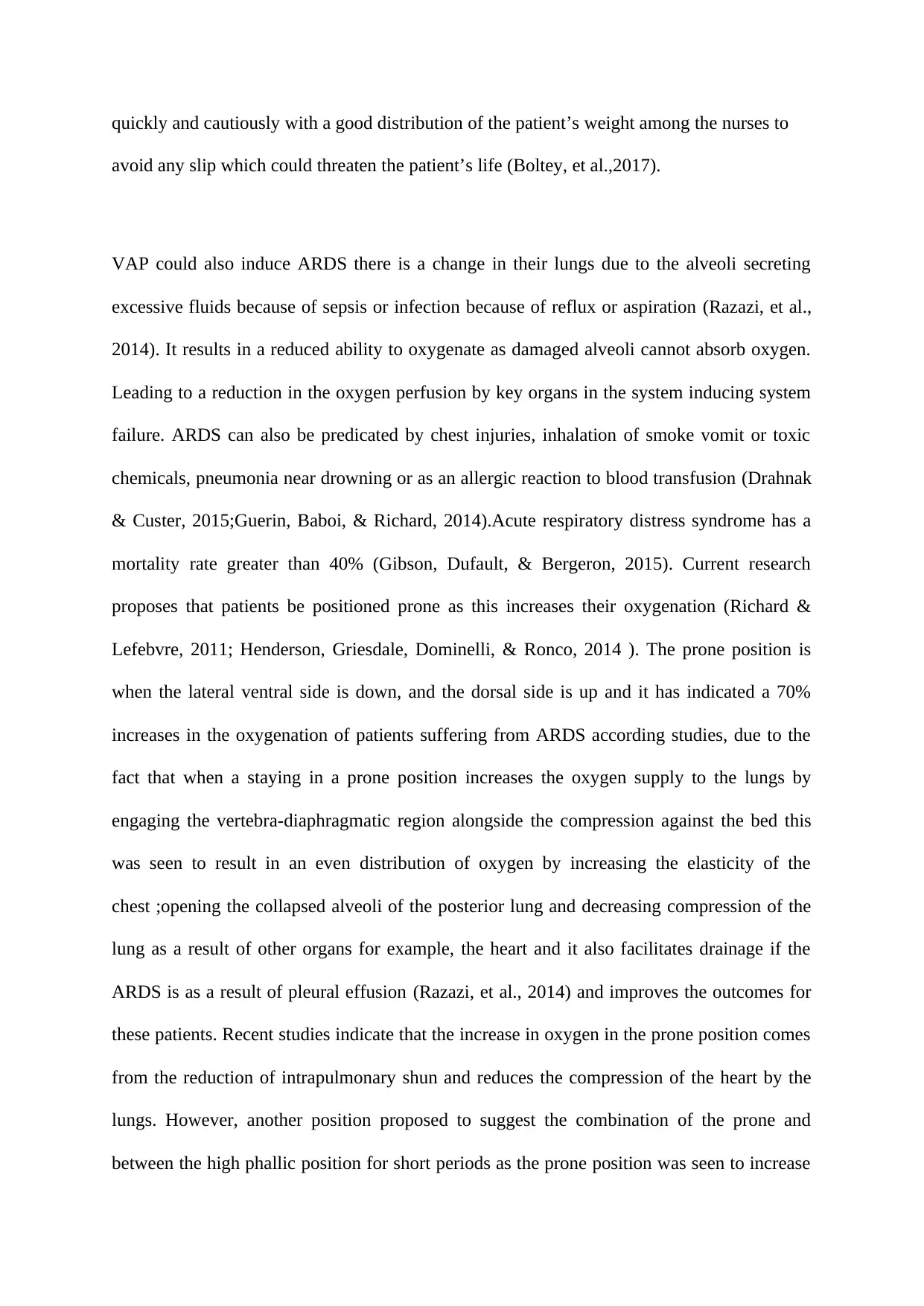
quickly and cautiously with a good distribution of the patient’s weight among the nurses to
avoid any slip which could threaten the patient’s life (Boltey, et al.,2017).
VAP could also induce ARDS there is a change in their lungs due to the alveoli secreting
excessive fluids because of sepsis or infection because of reflux or aspiration (Razazi, et al.,
2014). It results in a reduced ability to oxygenate as damaged alveoli cannot absorb oxygen.
Leading to a reduction in the oxygen perfusion by key organs in the system inducing system
failure. ARDS can also be predicated by chest injuries, inhalation of smoke vomit or toxic
chemicals, pneumonia near drowning or as an allergic reaction to blood transfusion (Drahnak
& Custer, 2015;Guerin, Baboi, & Richard, 2014).Acute respiratory distress syndrome has a
mortality rate greater than 40% (Gibson, Dufault, & Bergeron, 2015). Current research
proposes that patients be positioned prone as this increases their oxygenation (Richard &
Lefebvre, 2011; Henderson, Griesdale, Dominelli, & Ronco, 2014 ). The prone position is
when the lateral ventral side is down, and the dorsal side is up and it has indicated a 70%
increases in the oxygenation of patients suffering from ARDS according studies, due to the
fact that when a staying in a prone position increases the oxygen supply to the lungs by
engaging the vertebra-diaphragmatic region alongside the compression against the bed this
was seen to result in an even distribution of oxygen by increasing the elasticity of the
chest ;opening the collapsed alveoli of the posterior lung and decreasing compression of the
lung as a result of other organs for example, the heart and it also facilitates drainage if the
ARDS is as a result of pleural effusion (Razazi, et al., 2014) and improves the outcomes for
these patients. Recent studies indicate that the increase in oxygen in the prone position comes
from the reduction of intrapulmonary shun and reduces the compression of the heart by the
lungs. However, another position proposed to suggest the combination of the prone and
between the high phallic position for short periods as the prone position was seen to increase
avoid any slip which could threaten the patient’s life (Boltey, et al.,2017).
VAP could also induce ARDS there is a change in their lungs due to the alveoli secreting
excessive fluids because of sepsis or infection because of reflux or aspiration (Razazi, et al.,
2014). It results in a reduced ability to oxygenate as damaged alveoli cannot absorb oxygen.
Leading to a reduction in the oxygen perfusion by key organs in the system inducing system
failure. ARDS can also be predicated by chest injuries, inhalation of smoke vomit or toxic
chemicals, pneumonia near drowning or as an allergic reaction to blood transfusion (Drahnak
& Custer, 2015;Guerin, Baboi, & Richard, 2014).Acute respiratory distress syndrome has a
mortality rate greater than 40% (Gibson, Dufault, & Bergeron, 2015). Current research
proposes that patients be positioned prone as this increases their oxygenation (Richard &
Lefebvre, 2011; Henderson, Griesdale, Dominelli, & Ronco, 2014 ). The prone position is
when the lateral ventral side is down, and the dorsal side is up and it has indicated a 70%
increases in the oxygenation of patients suffering from ARDS according studies, due to the
fact that when a staying in a prone position increases the oxygen supply to the lungs by
engaging the vertebra-diaphragmatic region alongside the compression against the bed this
was seen to result in an even distribution of oxygen by increasing the elasticity of the
chest ;opening the collapsed alveoli of the posterior lung and decreasing compression of the
lung as a result of other organs for example, the heart and it also facilitates drainage if the
ARDS is as a result of pleural effusion (Razazi, et al., 2014) and improves the outcomes for
these patients. Recent studies indicate that the increase in oxygen in the prone position comes
from the reduction of intrapulmonary shun and reduces the compression of the heart by the
lungs. However, another position proposed to suggest the combination of the prone and
between the high phallic position for short periods as the prone position was seen to increase
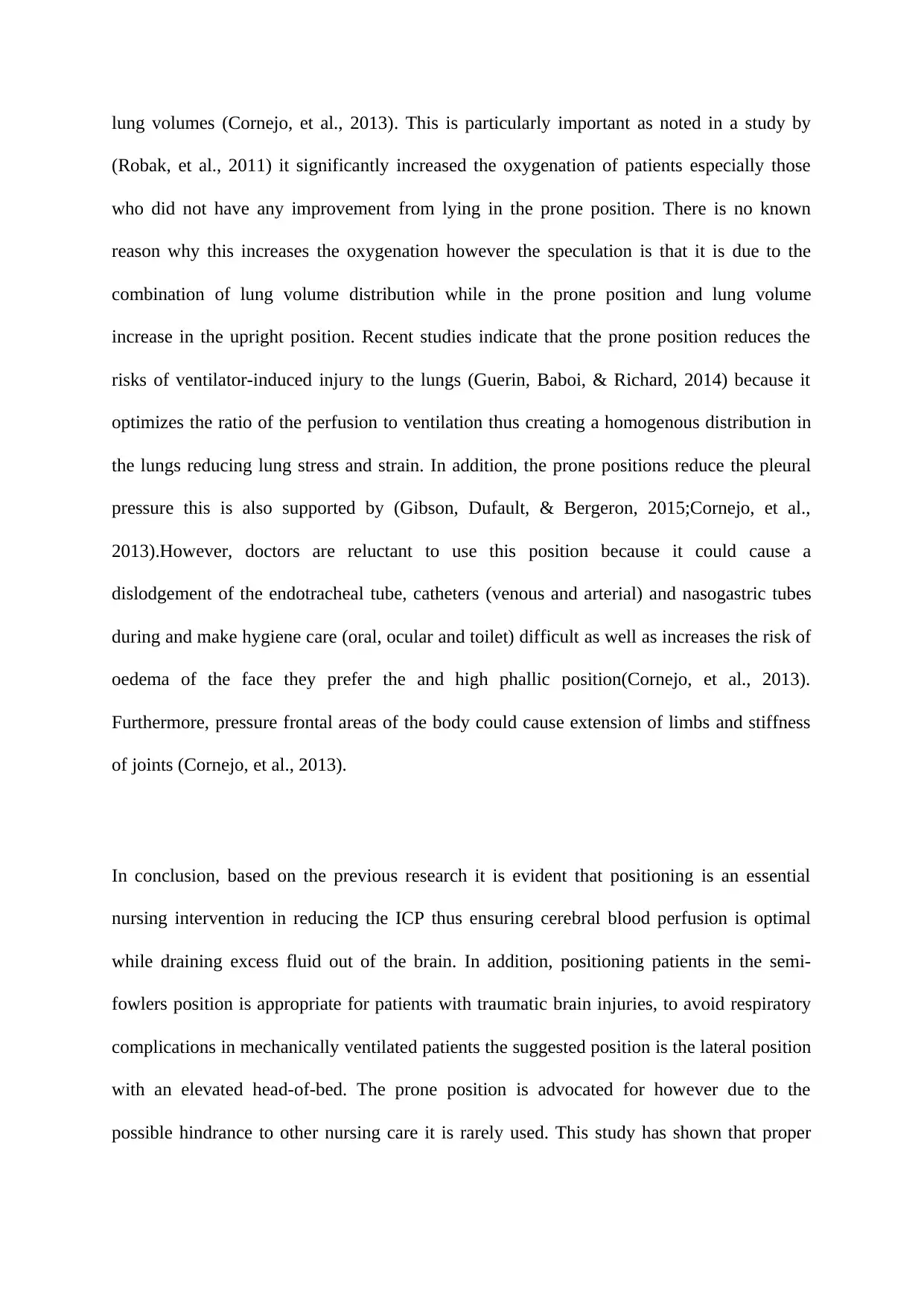
lung volumes (Cornejo, et al., 2013). This is particularly important as noted in a study by
(Robak, et al., 2011) it significantly increased the oxygenation of patients especially those
who did not have any improvement from lying in the prone position. There is no known
reason why this increases the oxygenation however the speculation is that it is due to the
combination of lung volume distribution while in the prone position and lung volume
increase in the upright position. Recent studies indicate that the prone position reduces the
risks of ventilator-induced injury to the lungs (Guerin, Baboi, & Richard, 2014) because it
optimizes the ratio of the perfusion to ventilation thus creating a homogenous distribution in
the lungs reducing lung stress and strain. In addition, the prone positions reduce the pleural
pressure this is also supported by (Gibson, Dufault, & Bergeron, 2015;Cornejo, et al.,
2013).However, doctors are reluctant to use this position because it could cause a
dislodgement of the endotracheal tube, catheters (venous and arterial) and nasogastric tubes
during and make hygiene care (oral, ocular and toilet) difficult as well as increases the risk of
oedema of the face they prefer the and high phallic position(Cornejo, et al., 2013).
Furthermore, pressure frontal areas of the body could cause extension of limbs and stiffness
of joints (Cornejo, et al., 2013).
In conclusion, based on the previous research it is evident that positioning is an essential
nursing intervention in reducing the ICP thus ensuring cerebral blood perfusion is optimal
while draining excess fluid out of the brain. In addition, positioning patients in the semi-
fowlers position is appropriate for patients with traumatic brain injuries, to avoid respiratory
complications in mechanically ventilated patients the suggested position is the lateral position
with an elevated head-of-bed. The prone position is advocated for however due to the
possible hindrance to other nursing care it is rarely used. This study has shown that proper
(Robak, et al., 2011) it significantly increased the oxygenation of patients especially those
who did not have any improvement from lying in the prone position. There is no known
reason why this increases the oxygenation however the speculation is that it is due to the
combination of lung volume distribution while in the prone position and lung volume
increase in the upright position. Recent studies indicate that the prone position reduces the
risks of ventilator-induced injury to the lungs (Guerin, Baboi, & Richard, 2014) because it
optimizes the ratio of the perfusion to ventilation thus creating a homogenous distribution in
the lungs reducing lung stress and strain. In addition, the prone positions reduce the pleural
pressure this is also supported by (Gibson, Dufault, & Bergeron, 2015;Cornejo, et al.,
2013).However, doctors are reluctant to use this position because it could cause a
dislodgement of the endotracheal tube, catheters (venous and arterial) and nasogastric tubes
during and make hygiene care (oral, ocular and toilet) difficult as well as increases the risk of
oedema of the face they prefer the and high phallic position(Cornejo, et al., 2013).
Furthermore, pressure frontal areas of the body could cause extension of limbs and stiffness
of joints (Cornejo, et al., 2013).
In conclusion, based on the previous research it is evident that positioning is an essential
nursing intervention in reducing the ICP thus ensuring cerebral blood perfusion is optimal
while draining excess fluid out of the brain. In addition, positioning patients in the semi-
fowlers position is appropriate for patients with traumatic brain injuries, to avoid respiratory
complications in mechanically ventilated patients the suggested position is the lateral position
with an elevated head-of-bed. The prone position is advocated for however due to the
possible hindrance to other nursing care it is rarely used. This study has shown that proper
Paraphrase This Document
Need a fresh take? Get an instant paraphrase of this document with our AI Paraphraser
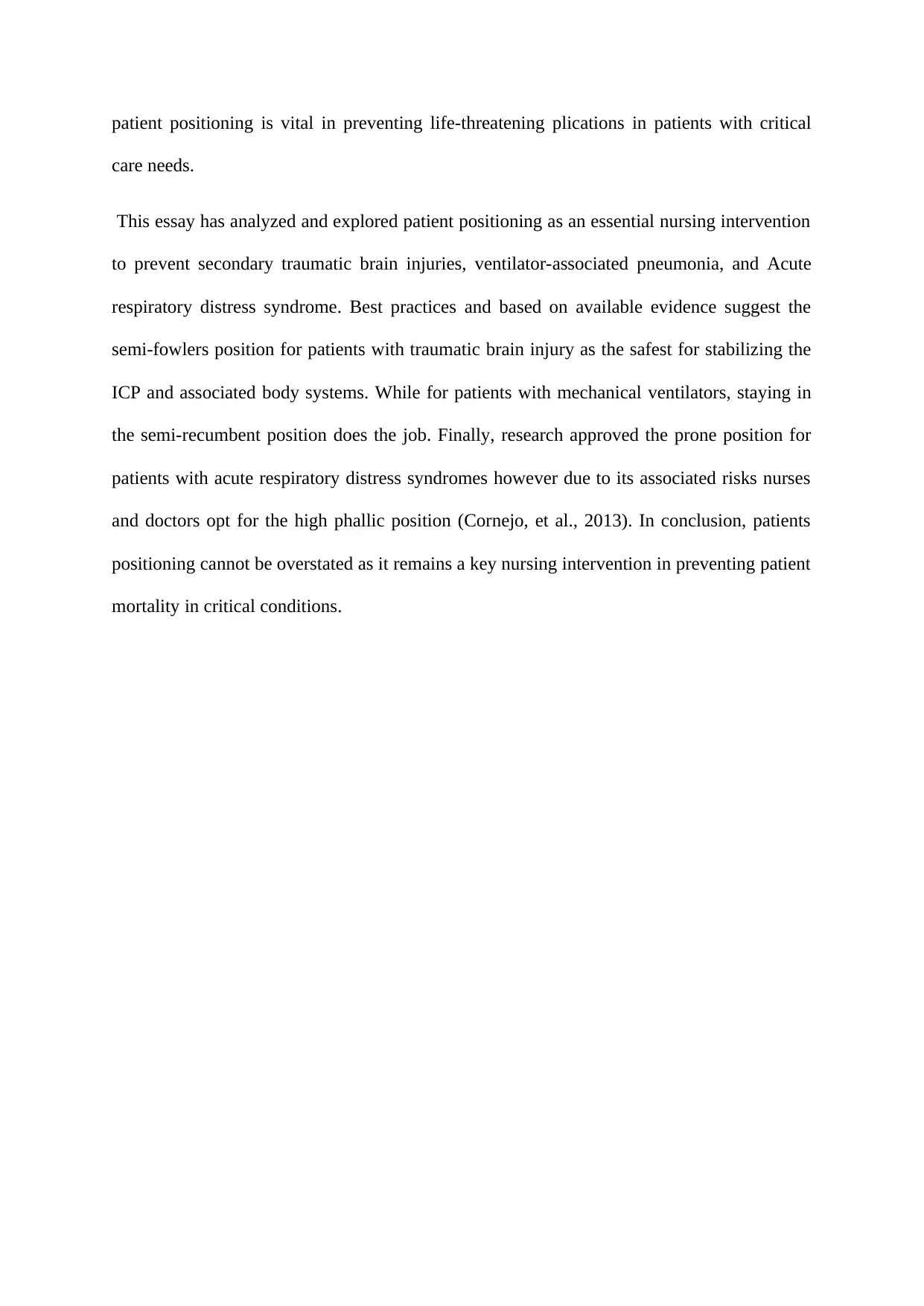
patient positioning is vital in preventing life-threatening plications in patients with critical
care needs.
This essay has analyzed and explored patient positioning as an essential nursing intervention
to prevent secondary traumatic brain injuries, ventilator-associated pneumonia, and Acute
respiratory distress syndrome. Best practices and based on available evidence suggest the
semi-fowlers position for patients with traumatic brain injury as the safest for stabilizing the
ICP and associated body systems. While for patients with mechanical ventilators, staying in
the semi-recumbent position does the job. Finally, research approved the prone position for
patients with acute respiratory distress syndromes however due to its associated risks nurses
and doctors opt for the high phallic position (Cornejo, et al., 2013). In conclusion, patients
positioning cannot be overstated as it remains a key nursing intervention in preventing patient
mortality in critical conditions.
care needs.
This essay has analyzed and explored patient positioning as an essential nursing intervention
to prevent secondary traumatic brain injuries, ventilator-associated pneumonia, and Acute
respiratory distress syndrome. Best practices and based on available evidence suggest the
semi-fowlers position for patients with traumatic brain injury as the safest for stabilizing the
ICP and associated body systems. While for patients with mechanical ventilators, staying in
the semi-recumbent position does the job. Finally, research approved the prone position for
patients with acute respiratory distress syndromes however due to its associated risks nurses
and doctors opt for the high phallic position (Cornejo, et al., 2013). In conclusion, patients
positioning cannot be overstated as it remains a key nursing intervention in preventing patient
mortality in critical conditions.
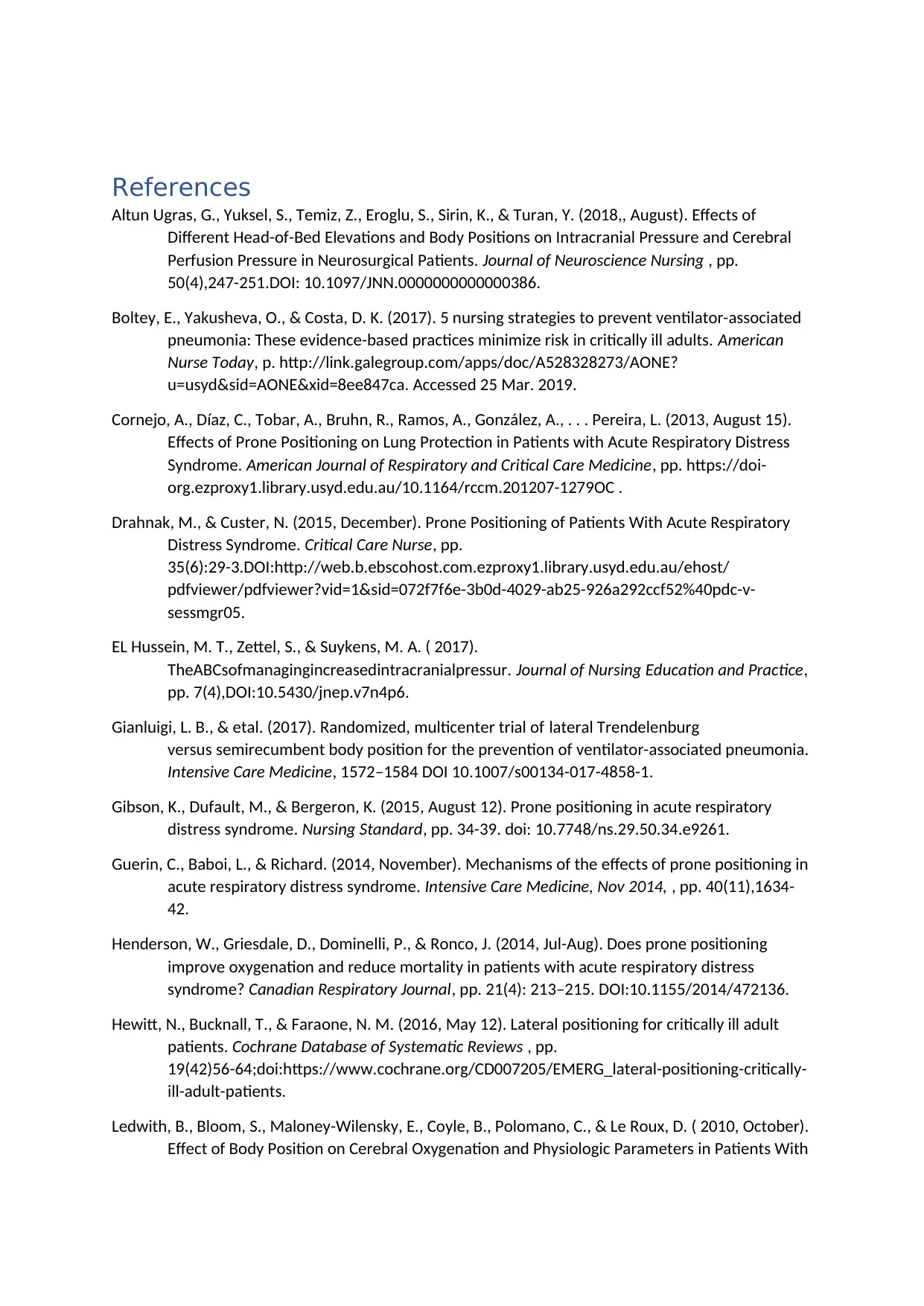
References
Altun Ugras, G., Yuksel, S., Temiz, Z., Eroglu, S., Sirin, K., & Turan, Y. (2018,, August). Effects of
Different Head-of-Bed Elevations and Body Positions on Intracranial Pressure and Cerebral
Perfusion Pressure in Neurosurgical Patients. Journal of Neuroscience Nursing , pp.
50(4),247-251.DOI: 10.1097/JNN.0000000000000386.
Boltey, E., Yakusheva, O., & Costa, D. K. (2017). 5 nursing strategies to prevent ventilator-associated
pneumonia: These evidence-based practices minimize risk in critically ill adults. American
Nurse Today, p. http://link.galegroup.com/apps/doc/A528328273/AONE?
u=usyd&sid=AONE&xid=8ee847ca. Accessed 25 Mar. 2019.
Cornejo, A., Díaz, C., Tobar, A., Bruhn, R., Ramos, A., González, A., . . . Pereira, L. (2013, August 15).
Effects of Prone Positioning on Lung Protection in Patients with Acute Respiratory Distress
Syndrome. American Journal of Respiratory and Critical Care Medicine, pp. https://doi-
org.ezproxy1.library.usyd.edu.au/10.1164/rccm.201207-1279OC .
Drahnak, M., & Custer, N. (2015, December). Prone Positioning of Patients With Acute Respiratory
Distress Syndrome. Critical Care Nurse, pp.
35(6):29-3.DOI:http://web.b.ebscohost.com.ezproxy1.library.usyd.edu.au/ehost/
pdfviewer/pdfviewer?vid=1&sid=072f7f6e-3b0d-4029-ab25-926a292ccf52%40pdc-v-
sessmgr05.
EL Hussein, M. T., Zettel, S., & Suykens, M. A. ( 2017).
TheABCsofmanagingincreasedintracranialpressur. Journal of Nursing Education and Practice,
pp. 7(4),DOI:10.5430/jnep.v7n4p6.
Gianluigi, L. B., & etal. (2017). Randomized, multicenter trial of lateral Trendelenburg
versus semirecumbent body position for the prevention of ventilator-associated pneumonia.
Intensive Care Medicine, 1572–1584 DOI 10.1007/s00134-017-4858-1.
Gibson, K., Dufault, M., & Bergeron, K. (2015, August 12). Prone positioning in acute respiratory
distress syndrome. Nursing Standard, pp. 34-39. doi: 10.7748/ns.29.50.34.e9261.
Guerin, C., Baboi, L., & Richard. (2014, November). Mechanisms of the effects of prone positioning in
acute respiratory distress syndrome. Intensive Care Medicine, Nov 2014, , pp. 40(11),1634-
42.
Henderson, W., Griesdale, D., Dominelli, P., & Ronco, J. (2014, Jul-Aug). Does prone positioning
improve oxygenation and reduce mortality in patients with acute respiratory distress
syndrome? Canadian Respiratory Journal, pp. 21(4): 213–215. DOI:10.1155/2014/472136.
Hewitt, N., Bucknall, T., & Faraone, N. M. (2016, May 12). Lateral positioning for critically ill adult
patients. Cochrane Database of Systematic Reviews , pp.
19(42)56-64;doi:https://www.cochrane.org/CD007205/EMERG_lateral-positioning-critically-
ill-adult-patients.
Ledwith, B., Bloom, S., Maloney-Wilensky, E., Coyle, B., Polomano, C., & Le Roux, D. ( 2010, October).
Effect of Body Position on Cerebral Oxygenation and Physiologic Parameters in Patients With
Altun Ugras, G., Yuksel, S., Temiz, Z., Eroglu, S., Sirin, K., & Turan, Y. (2018,, August). Effects of
Different Head-of-Bed Elevations and Body Positions on Intracranial Pressure and Cerebral
Perfusion Pressure in Neurosurgical Patients. Journal of Neuroscience Nursing , pp.
50(4),247-251.DOI: 10.1097/JNN.0000000000000386.
Boltey, E., Yakusheva, O., & Costa, D. K. (2017). 5 nursing strategies to prevent ventilator-associated
pneumonia: These evidence-based practices minimize risk in critically ill adults. American
Nurse Today, p. http://link.galegroup.com/apps/doc/A528328273/AONE?
u=usyd&sid=AONE&xid=8ee847ca. Accessed 25 Mar. 2019.
Cornejo, A., Díaz, C., Tobar, A., Bruhn, R., Ramos, A., González, A., . . . Pereira, L. (2013, August 15).
Effects of Prone Positioning on Lung Protection in Patients with Acute Respiratory Distress
Syndrome. American Journal of Respiratory and Critical Care Medicine, pp. https://doi-
org.ezproxy1.library.usyd.edu.au/10.1164/rccm.201207-1279OC .
Drahnak, M., & Custer, N. (2015, December). Prone Positioning of Patients With Acute Respiratory
Distress Syndrome. Critical Care Nurse, pp.
35(6):29-3.DOI:http://web.b.ebscohost.com.ezproxy1.library.usyd.edu.au/ehost/
pdfviewer/pdfviewer?vid=1&sid=072f7f6e-3b0d-4029-ab25-926a292ccf52%40pdc-v-
sessmgr05.
EL Hussein, M. T., Zettel, S., & Suykens, M. A. ( 2017).
TheABCsofmanagingincreasedintracranialpressur. Journal of Nursing Education and Practice,
pp. 7(4),DOI:10.5430/jnep.v7n4p6.
Gianluigi, L. B., & etal. (2017). Randomized, multicenter trial of lateral Trendelenburg
versus semirecumbent body position for the prevention of ventilator-associated pneumonia.
Intensive Care Medicine, 1572–1584 DOI 10.1007/s00134-017-4858-1.
Gibson, K., Dufault, M., & Bergeron, K. (2015, August 12). Prone positioning in acute respiratory
distress syndrome. Nursing Standard, pp. 34-39. doi: 10.7748/ns.29.50.34.e9261.
Guerin, C., Baboi, L., & Richard. (2014, November). Mechanisms of the effects of prone positioning in
acute respiratory distress syndrome. Intensive Care Medicine, Nov 2014, , pp. 40(11),1634-
42.
Henderson, W., Griesdale, D., Dominelli, P., & Ronco, J. (2014, Jul-Aug). Does prone positioning
improve oxygenation and reduce mortality in patients with acute respiratory distress
syndrome? Canadian Respiratory Journal, pp. 21(4): 213–215. DOI:10.1155/2014/472136.
Hewitt, N., Bucknall, T., & Faraone, N. M. (2016, May 12). Lateral positioning for critically ill adult
patients. Cochrane Database of Systematic Reviews , pp.
19(42)56-64;doi:https://www.cochrane.org/CD007205/EMERG_lateral-positioning-critically-
ill-adult-patients.
Ledwith, B., Bloom, S., Maloney-Wilensky, E., Coyle, B., Polomano, C., & Le Roux, D. ( 2010, October).
Effect of Body Position on Cerebral Oxygenation and Physiologic Parameters in Patients With
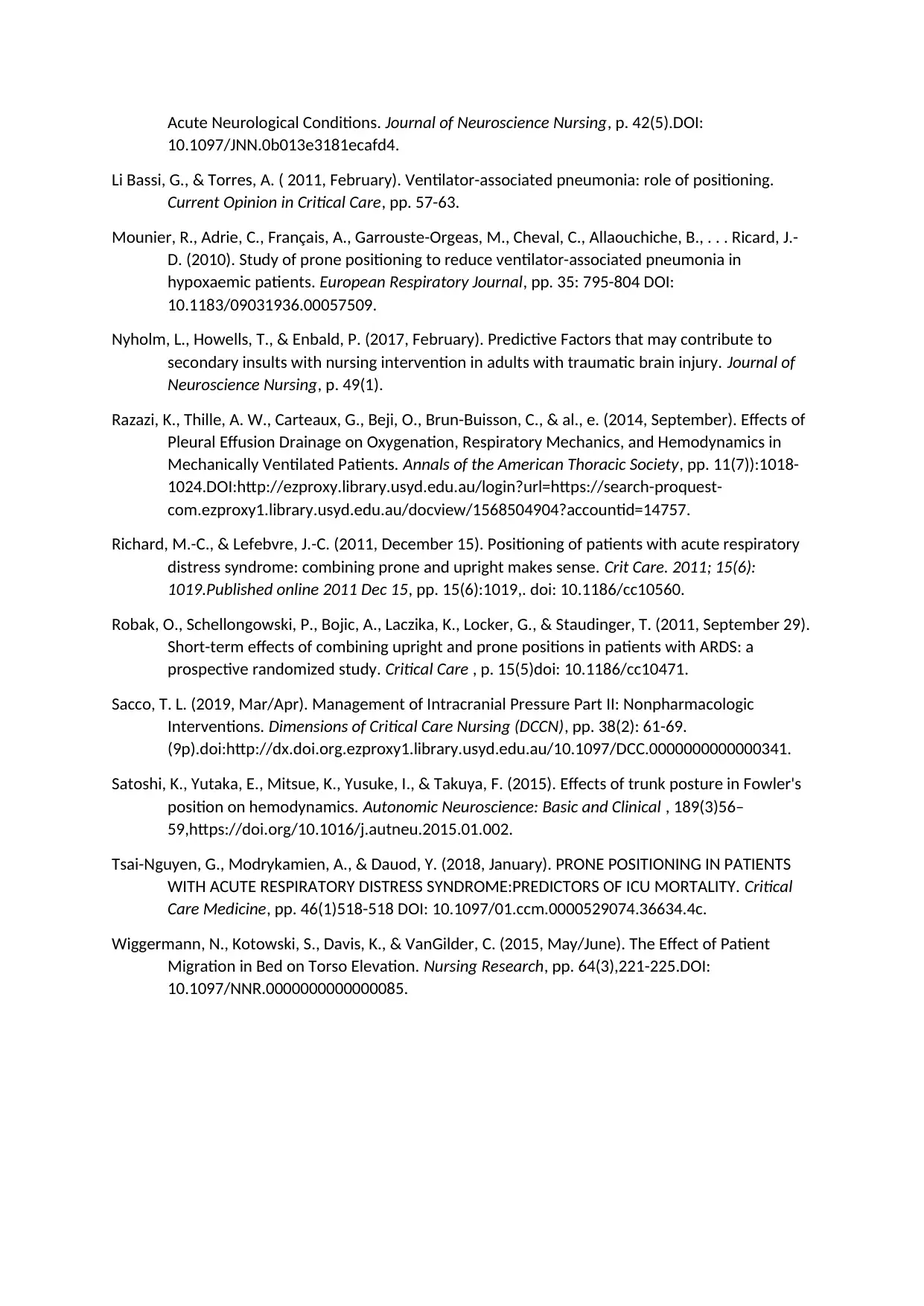
Acute Neurological Conditions. Journal of Neuroscience Nursing, p. 42(5).DOI:
10.1097/JNN.0b013e3181ecafd4.
Li Bassi, G., & Torres, A. ( 2011, February). Ventilator-associated pneumonia: role of positioning.
Current Opinion in Critical Care, pp. 57-63.
Mounier, R., Adrie, C., Français, A., Garrouste-Orgeas, M., Cheval, C., Allaouchiche, B., . . . Ricard, J.-
D. (2010). Study of prone positioning to reduce ventilator-associated pneumonia in
hypoxaemic patients. European Respiratory Journal, pp. 35: 795-804 DOI:
10.1183/09031936.00057509.
Nyholm, L., Howells, T., & Enbald, P. (2017, February). Predictive Factors that may contribute to
secondary insults with nursing intervention in adults with traumatic brain injury. Journal of
Neuroscience Nursing, p. 49(1).
Razazi, K., Thille, A. W., Carteaux, G., Beji, O., Brun-Buisson, C., & al., e. (2014, September). Effects of
Pleural Effusion Drainage on Oxygenation, Respiratory Mechanics, and Hemodynamics in
Mechanically Ventilated Patients. Annals of the American Thoracic Society, pp. 11(7)):1018-
1024.DOI:http://ezproxy.library.usyd.edu.au/login?url=https://search-proquest-
com.ezproxy1.library.usyd.edu.au/docview/1568504904?accountid=14757.
Richard, M.-C., & Lefebvre, J.-C. (2011, December 15). Positioning of patients with acute respiratory
distress syndrome: combining prone and upright makes sense. Crit Care. 2011; 15(6):
1019.Published online 2011 Dec 15, pp. 15(6):1019,. doi: 10.1186/cc10560.
Robak, O., Schellongowski, P., Bojic, A., Laczika, K., Locker, G., & Staudinger, T. (2011, September 29).
Short-term effects of combining upright and prone positions in patients with ARDS: a
prospective randomized study. Critical Care , p. 15(5)doi: 10.1186/cc10471.
Sacco, T. L. (2019, Mar/Apr). Management of Intracranial Pressure Part II: Nonpharmacologic
Interventions. Dimensions of Critical Care Nursing (DCCN), pp. 38(2): 61-69.
(9p).doi:http://dx.doi.org.ezproxy1.library.usyd.edu.au/10.1097/DCC.0000000000000341.
Satoshi, K., Yutaka, E., Mitsue, K., Yusuke, I., & Takuya, F. (2015). Effects of trunk posture in Fowler's
position on hemodynamics. Autonomic Neuroscience: Basic and Clinical , 189(3)56–
59,https://doi.org/10.1016/j.autneu.2015.01.002.
Tsai-Nguyen, G., Modrykamien, A., & Dauod, Y. (2018, January). PRONE POSITIONING IN PATIENTS
WITH ACUTE RESPIRATORY DISTRESS SYNDROME:PREDICTORS OF ICU MORTALITY. Critical
Care Medicine, pp. 46(1)518-518 DOI: 10.1097/01.ccm.0000529074.36634.4c.
Wiggermann, N., Kotowski, S., Davis, K., & VanGilder, C. (2015, May/June). The Effect of Patient
Migration in Bed on Torso Elevation. Nursing Research, pp. 64(3),221-225.DOI:
10.1097/NNR.0000000000000085.
10.1097/JNN.0b013e3181ecafd4.
Li Bassi, G., & Torres, A. ( 2011, February). Ventilator-associated pneumonia: role of positioning.
Current Opinion in Critical Care, pp. 57-63.
Mounier, R., Adrie, C., Français, A., Garrouste-Orgeas, M., Cheval, C., Allaouchiche, B., . . . Ricard, J.-
D. (2010). Study of prone positioning to reduce ventilator-associated pneumonia in
hypoxaemic patients. European Respiratory Journal, pp. 35: 795-804 DOI:
10.1183/09031936.00057509.
Nyholm, L., Howells, T., & Enbald, P. (2017, February). Predictive Factors that may contribute to
secondary insults with nursing intervention in adults with traumatic brain injury. Journal of
Neuroscience Nursing, p. 49(1).
Razazi, K., Thille, A. W., Carteaux, G., Beji, O., Brun-Buisson, C., & al., e. (2014, September). Effects of
Pleural Effusion Drainage on Oxygenation, Respiratory Mechanics, and Hemodynamics in
Mechanically Ventilated Patients. Annals of the American Thoracic Society, pp. 11(7)):1018-
1024.DOI:http://ezproxy.library.usyd.edu.au/login?url=https://search-proquest-
com.ezproxy1.library.usyd.edu.au/docview/1568504904?accountid=14757.
Richard, M.-C., & Lefebvre, J.-C. (2011, December 15). Positioning of patients with acute respiratory
distress syndrome: combining prone and upright makes sense. Crit Care. 2011; 15(6):
1019.Published online 2011 Dec 15, pp. 15(6):1019,. doi: 10.1186/cc10560.
Robak, O., Schellongowski, P., Bojic, A., Laczika, K., Locker, G., & Staudinger, T. (2011, September 29).
Short-term effects of combining upright and prone positions in patients with ARDS: a
prospective randomized study. Critical Care , p. 15(5)doi: 10.1186/cc10471.
Sacco, T. L. (2019, Mar/Apr). Management of Intracranial Pressure Part II: Nonpharmacologic
Interventions. Dimensions of Critical Care Nursing (DCCN), pp. 38(2): 61-69.
(9p).doi:http://dx.doi.org.ezproxy1.library.usyd.edu.au/10.1097/DCC.0000000000000341.
Satoshi, K., Yutaka, E., Mitsue, K., Yusuke, I., & Takuya, F. (2015). Effects of trunk posture in Fowler's
position on hemodynamics. Autonomic Neuroscience: Basic and Clinical , 189(3)56–
59,https://doi.org/10.1016/j.autneu.2015.01.002.
Tsai-Nguyen, G., Modrykamien, A., & Dauod, Y. (2018, January). PRONE POSITIONING IN PATIENTS
WITH ACUTE RESPIRATORY DISTRESS SYNDROME:PREDICTORS OF ICU MORTALITY. Critical
Care Medicine, pp. 46(1)518-518 DOI: 10.1097/01.ccm.0000529074.36634.4c.
Wiggermann, N., Kotowski, S., Davis, K., & VanGilder, C. (2015, May/June). The Effect of Patient
Migration in Bed on Torso Elevation. Nursing Research, pp. 64(3),221-225.DOI:
10.1097/NNR.0000000000000085.
1 out of 10
Your All-in-One AI-Powered Toolkit for Academic Success.
+13062052269
info@desklib.com
Available 24*7 on WhatsApp / Email
![[object Object]](/_next/static/media/star-bottom.7253800d.svg)
Unlock your academic potential
© 2024 | Zucol Services PVT LTD | All rights reserved.